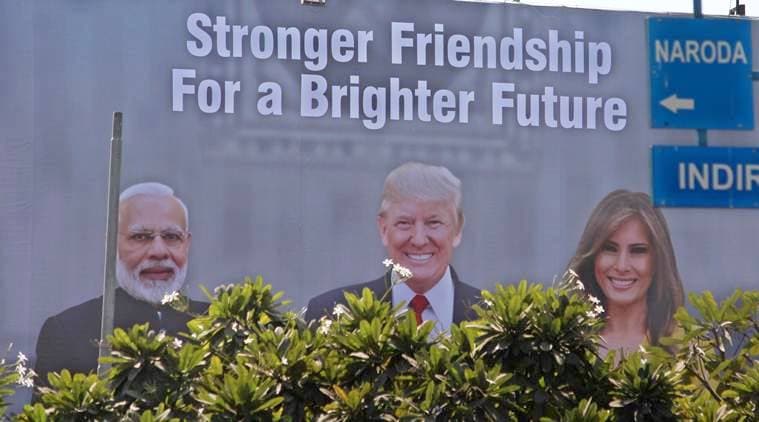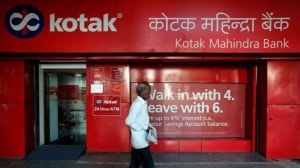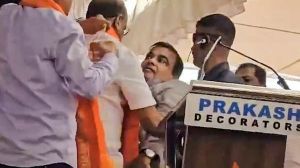- India
- International
Trump govt seems supportive of India as part of its Indo-Pacific strategy, while also counting gains for itself
Trump administration seems supportive of India as part of its Indo-Pacific strategy, while also counting gains for itself.
 Historically, four factors have affected the India-US relationship at any point of time: US global posture and priorities; strength of bilateral relations; role assigned to Pakistan in its global objectives; strategy towards China.
Historically, four factors have affected the India-US relationship at any point of time: US global posture and priorities; strength of bilateral relations; role assigned to Pakistan in its global objectives; strategy towards China.
The stage is now set for the 36-hour Donald Trump show. He will arrive today in Ahmedabad, and will be received, in a gesture usual towards visiting US presidents, by the prime minister himself at the airport. They will drive together to the newly constructed Motera stadium, with a record capacity of more than one lakh. He has cited this approvingly in several of his recent speeches in US, pointing out that this is double of what he draws in the US. He says he has been promised huge crowds along the route. These are the only two aspects he has repeatedly mentioned while talking publicly about the India visit. After a three-hour stay, he will fly to Agra, for the iconic moment with his wife in front of the Taj Mahal, and reach Delhi later the same evening.
EXPLAINED | India-US ties, over the years
In Delhi, the programme is a standard one, with the ceremonial welcome in the forecourt of Rashtrapati Bhavan, homage at Rajghat, talks with the PM and subsequent press comments at Hyderabad House, a business meeting arranged by the US embassy, a banquet hosted by the US President, and then flying out immediately thereafter. He will not be addressing a joint session of Indian parliament, reflecting, no doubt, the opposition he inevitably generates in political groups everywhere.
Neither side has so far publicly touted any major substantive outcomes of the visit. To create some positive atmospherics, the Indian Cabinet Committee on Security just gave final approval to $3 billion worth of pending contracts to purchase military helicopters from US companies Lockheed Martin and Boeing. The US Administration, on its part, informed Congress of its willingness to authorise sale of another $1.8 billion worth missile defence system, indicative of its growing willingness to allow higher technology defence equipment to India. The Trump Administration has gone farther than its predecessors in the technology levels it is willing to offer, including Guardian drones in 2017, and placing India at STA-1 level, similar to its closest allies and partners.
Read | As Trump visits India, on the table: plan to counter China’s reach with Blue Dot network
The spokesperson of the Ministry of External Affairs indicated on February 20 that five MoUs can be expected, inter alia, on intellectual property, trade facilitation and homeland security. There will also be the regulation joint statement. This time it will be parsed in more than usual detail for indications of future direction and intent for the partnership, when the US has been talking of “Make America Great Again”, advocating for sovereignty and nationalism rather than the post 1990 globalisation, decrying alliance commitments, readying to sign an agreement with the Taliban by month-end leading to a drawdown of US troop presence, yet articulating repeatedly about India being a lynch pin of its “Free and Open Indo-Pacific Strategy”.

The two countries have not been able to finalise even a “limited trade package”, which has been under discussion for two years. Obviously, there is a gap between what India can accommodate, and what the US negotiators want for their own political reasons. The Trump administration has taken several steps that have negatively impacted on India. It has imposed additional tariffs on steel and aluminum imports from India, ostensibly on national security grounds. This flies in the face of citing strategic partnership and convergence in Indo-Pacific strategy. It has withdrawn hitherto available GSP benefits from certain categories of labour intensive Indian products. It has taken India out of its list of “developing” countries, lowering the threshold for countervailing trade action. These go against the grain of the US articulation that it sees the rise of India to be in US benefit. It also does not make sense when India is an overall trade deficit country, even though it has a $20 billion surplus with the US which pales compared to China’s $350 billion surplus. On trade, however, Trump has taken unprecedented action against the closest US allies. He has also repeatedly publicly ridiculed Indian tariffs, claiming recently that India has not treated the US fairly.
Given the contradictory impulses, it would be fair to ask what the future holds for the India-US relationship, and where would the Trump visit and its aftermath take us. Can India consider the US a reliable and “all weather” partner, or be constantly juggling convergences and divergences? Is it better for India when a Democrat or a Republican is president?
Historically, four factors have affected the India-US relationship at any point of time: US global posture and priorities; strength of bilateral relations; role assigned to Pakistan in its global objectives; strategy towards China.
During the Second World War, Democrat Roosevelt pushed Britain to grant independence to India, facilitated a separate official Indian representation in Washington through an Agent General since 1941, but did not go far enough fearing disruption of the necessary war time alliance. In the post war period, Democrat Truman spoke of partnering with developing countries for their industrial and scientific progress, welcomed Indian PM Nehru for an acclaimed visit in 1949, but initiated the Cold War containment strategy against the Soviet Union, and the assessment of newly independent countries from that lens. Republican Eisenhower embraced and armed Pakistan in its CENTO and SEATO military alliances, but emphasised food and economic assistance to India seeing it as a democratic bulwark against a Communist China, and made a successful first-ever visit of a serving US President to India, welcomed also by a 5 lakh crowd in Connaught Place.
Democrat Kennedy was extremely supportive of democratic India’s economic assistance requirements, and for military assistance during the 1962 China conflict. Republican Nixon visited India for a day in 1959, was upset with Indian criticism of his Vietnam military offensives, sided completely with Pakistan during the Bangladesh crisis of 1971, sent the US seventh fleet into the Bay of Bengal to pressurise India, and sought to reorder the global balance by outreach to China through a secret Kissinger visit that year. Democrat Carter, wedded to human rights issues, acclaimed India’s post Emergency elections, but was critical on non- proliferation differences. Republican Reagan explored economic and science cooperation with India, but was absorbed with Pakistan’s support in pushing the Soviet Union out of Afghanistan. Democrat Clinton stabilised the relationship after the dissonance and sanctions following our 1998 nuclear tests, and gave full support to India’s position during the 1999 Kargil conflict with Pakistan. Republican George W Bush transformed the relationship with the civil nuclear cooperation agreement of 2008, perceiving again the technological, military and political challenge to the US from a rising China. Democrat Obama came out in support of India’s permanent membership of the UN Security Council, and declared India a Major Defence Partner, enabling higher level technology authorisations.
It is clear, therefore, that India’s interests have been impacted a bit by party orientation on issues, but more by the overall global circumstance. Trump, who is around for at least one or possibly five more years, wants to focus on reviving US manufacturing and technological edge, reduce its sapping overseas military involvements, and has come out stridently against what his administration describes as Chinese unfair trade, forced technology transfer practices and theft of intellectual property.
Under Trump, therefore, we will have to deal with a transactional administration, supportive of strengthening India as part of its Indo-Pacific strategy, but also counting the gains for itself.
The writer is former Indian ambassador to US, France and Israel
EXPRESS OPINION
More Explained
Apr 24: Latest News
- 01
- 02
- 03
- 04
- 05










































